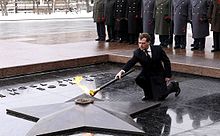Tomb of the Unknown Soldier (Moscow)

The Tomb of the Unknown Soldier (Могила Неизвестного Солдата in Russian, or Mogila Neizvestnova Soldata) is a war memorial, dedicated to the Soviet soldiers killed during the Great Patriotic War of 1941-1945. It is located at the Kremlin Wall in the Alexander Garden in Moscow.

The remains of the unknown soldiers, killed in the Battle of Moscow in 1941 and initially buried in a mass grave at the 41st km of the Leningrad highway, were relocated to the Kremlin Wall in December of 1966 (25th anniversary of the battle). The Tomb of the Unknown Soldier was unveiled on May 8, 1967. The torch for the memorial's Eternal Flame was transported from Leningrad, where it had been lit from the Eternal Flame at the Field of Mars.

The Tomb of the Unknown Soldier was designed by architects D. I. Burdin, V. A. Klimov, Yu. R. Rabayev and sculptor Nikolai Tomsky. The centerpiece of the memorial is a platform, which consists of big plates made of polished red granite. The tombstone itself, installed in 1975, is decorated with a bronze sculpture of a laurel branch and a soldier's helmet laid upon a banner.
In front of the tombstone, there is a five-pointed star in a square pit, which emanates the Eternal Flame of Glory from its center. The flame illuminates a bronze inscription "Имя твоё неизвестно, подвиг твой бессмертен" (translit.: Imya tvoyo neizvestno, podvig tvoy bessmerten, "Your name is unknown, your deed is immortal").
To the left of the tomb, there is a granite wall with an inlay saying "1941 - To Those Who Have Fallen For The Motherland - 1945". To the right of the tomb, there is a granite alley made of porphyry plates with incapsulated soils from hero cities, Leningrad, Kiev, Volgograd, Odessa, Sevastopol, Minsk, Kerch, Novorossiysk, Tula and Brest. The plate for Volgograd has since been changed to Stalingrad, the city's name during the Second World War.
In 1997, a Guard of Honour (which had guarded the Lenin Mausoleum) was restored at the Tomb of the Unknown Soldier by the federal law of December 8, 1997, "On Immortalizing the Soviet People’s Victory in the Great Patriotic War of 1941-1945".

See also
55°45′17″N 37°36′58″E / 55.75472°N 37.61611°E
